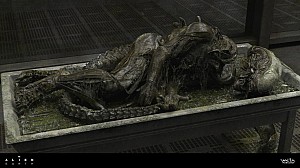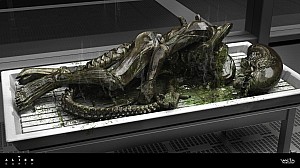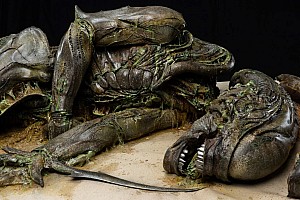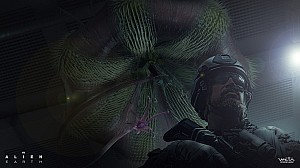LV-426: A Truly Strange Space Oddity
Prometheus Forum Topic

Chris
AdminEngineerJun 4, 20134732 Views2 Replies[center][i]The following is a guest post, I'm publishing on the author's behalf, enjoy![/i][/center]
It's never been a more exciting time for astrophysics and, in particular, the hunt for extra-solar planets. New worlds are being discovered on an almost weekly basis, some of which have set the imagination aflame at the possibility of them being inhabited (or at least having the capability of harboring life as we know it).
But even before the first exoplanet discovery was confirmed in 1995, we've been dreaming of strange planets beyond our own solar system. Arguably, no such imagined celestial body is as tangible - and terrible - as LV-426, a small moon in the Zeta II Reticuli system and home to the nightmarish xenomorphs.
[center]
[img]http://www.prometheus2-movie.com/uploads/lv426_1.png[/img]
[/center]
But what do we really know about LV-426? What would NASA physicists be able to tell us - in an astronomical sense - about the moon if we were to find it within our own solar system (heaven forbid?)
[i]*Note that all scientific assertions are based purely on plot points, observational impressions and details explicitly given within the canonical films and books only. Games and non-canon fiction were not considered.[/i]
[b]Size and Mass[/b]
The make-up of LV-426 - or Acheron, as colonists came to call it - is rather strange, and that's before we come to address the murderous predators scuttling around the surface.
What's most remarkable about Acheron is that it's tiny in volume, but isn't too far off planet Earth in terms of mass.
Acheron is listed as being around 600km in radius. A very good size comparison would be Charon, a satellite of Pluto which has a radius of 600km - half as big as Pluto itself. To put this into perspective, Charon is in the bottom left:
[center]
[img]http://www.prometheus2-movie.com/uploads/lv426_2.png[/img]
[/center]
So, by planetary standards Acheron is rather minuscule. What's remarkable here is that it has a surface gravity measuring 86% of the Earth's; this is greatly at odds with its size, considering that its real-life counterpart Charon only has 0.2% of our planet's pull.
In fact, Acheron has roughly the same gravity as Uranus despite the fact that Uranus is over forty times the size. We know the core of Acheron is molten, but we don’t know exactly what it consists of - all we can assume is that it must have an extremely unusual core made up of something nearly ten times heavier than iron, and no known element fits this planetary anomaly.
[b]Temperature[/b]
Although you wouldn't want to take a stroll on Acheron due to the xenomorphs, razor-sharp rocks, brutal weather and atmosphere (more on those in a bit), it’s temperature would actually be the least of your worries.
Holding steady between -40 and +60 °C, it's actually less variant than the hot and cold extremes we see on planet Earth. This could be due to that giant molten core of mystery gloop, which would kick out a great degree of heat just below the surface and circulated by the very active weather system. Alternatively, it could have inherited its rare, habitable temperature as a by-product of being in a binary star-system (Zeta II Reticuli). Until further information is available, we might assume it’s a combination of these factors and possibly more.
[b]Atmosphere[/b]
While the lack of oxygen is what would inhibit us taking a long, deep huff of Acheron air, its atmosphere isn't entirely inhospitable.
Ignoring any effects of the Weyland-Yutani terraforming activities, the main ingredient of Acheron's atmosphere is nitrogen at 85% - just above our own, which is 78%. However, whereas the remainder of our atmosphere is predominantly oxygen, Acheron’s is a toxic soup of argon (10%) and neon (5%) alongside some other trace gasses.
But while we'd need to keep up the terraforming in order to make it human-friendly, it's not inconceivable that it wouldn't sort itself out over time. The warm temperature coupled with the known abundance of methane, could kick start a healthy level of global warming and melt water ice. While no endemic lifeforms are known to have made the moon a home, it's easy to imagine Acheron as primordial and not too far (in a cosmological sense) from an abiogenesis event.
[b]Weather System[/b]
Given the severe winds which seem to permanently move across its surface - as well as the high water vapor content - has given rise to some very extreme rock erosion effects, as evidenced by the bizarre features carved into the surface rock.
[center]
[img]http://www.prometheus2-movie.com/uploads/lv426_3.png[/img]
[/center]
The strength of the winds on LV-426 are likely to be frequently over 60mph (if not higher) in order to produce the same effects in dense igneous rock as if it were sandstone, as can be seen in the Mauritian geology on the right.
However, the extreme winds never culminate in fully-blown storms and hurricanes. While we don’t know of any real-life examples of moons as small as Acheron and have a substantial atmosphere, it's unlikely that the moon would be big enough to sustain an atmospheric storm.
[b]Physical Location and Star System[/b]
... and this is where the science breaks down, because we simply don't know. Arguably, Ridley Scott and his writers are equally nonplussed, not only by its location with regards to planet Earth but also its relationship with the surrounding moons and stars.
We're relatively certain that LV-426 is a moon around the ring planet Calpamos, along with its sister moon LV-223 (which features in Prometheus) and at least one other moon not explored in the Alien canon. Calpamos itself is a fictional planet but listed as being in Zeta Reticuli, a very real star system.
[center]
[img]http://www.prometheus2-movie.com/uploads/lv426_4.png[/img]
[/center]
But characters mention distances which don’t add up, refer to the moons as planets occasionally (and vice-versa) and the relationship between the two moons and their home planet is about as clear as mud. Essentially, everything in the previous paragraph could be incorrect but just when you think you've got it nailed, someone will point out a contradictory piece of information from a DVD extra. Even Neil DeGrasse Tyson [url=http://www.geekosystem.com/ndgt-prometheus-bad-math/]took a swing[/url] at the numbers.
Not that it matters, of course. The follow up to Prometheus may well shed further light on this dark corner of the Universe, and even if it doesn't, it's fun to speculate. In [url=http://www.nyfa.edu/]film schools across the country[/url], students are considered to utilize real-world locations in order to excite their creative juiced; nowhere is that advice more apt than space.
But until we've got more information to go off, we'll have to revel in the discovery of real exoplanets until we can speculate more on the nightmarish world of Acheron.
Replies to LV-426: A Truly Strange Space Oddity
Hey Guest, want to add your say?
Are you an avid Alien fan looking for a dedicated online community of likeminded fans? Look no further! Create your own profile today and take part in our forums and gain XP points for all the content you post!










